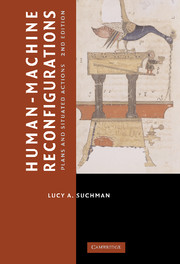Book contents
- Frontmatter
- Contents
- Acknowledgments
- Preface to the 2nd Edition
- Introduction
- 1 Readings and Responses
- 2 Preface to the 1st Edition
- 3 Introduction to the 1st Edition
- 4 Interactive Artifacts
- 5 Plans
- 6 Situated Actions
- 7 Communicative Resources
- 8 Case and Methods
- 9 Human–Machine Communication
- 10 Conclusion to the 1st Edition
- 11 Plans, Scripts, and Other Ordering Devices
- 12 Agencies at the Interface
- 13 Figuring the Human in AI and Robotics
- 14 Demystifications and Reenchantments of the Humanlike Machine
- 15 Reconfigurations
- References
- Index
11 - Plans, Scripts, and Other Ordering Devices
Published online by Cambridge University Press: 05 June 2012
- Frontmatter
- Contents
- Acknowledgments
- Preface to the 2nd Edition
- Introduction
- 1 Readings and Responses
- 2 Preface to the 1st Edition
- 3 Introduction to the 1st Edition
- 4 Interactive Artifacts
- 5 Plans
- 6 Situated Actions
- 7 Communicative Resources
- 8 Case and Methods
- 9 Human–Machine Communication
- 10 Conclusion to the 1st Edition
- 11 Plans, Scripts, and Other Ordering Devices
- 12 Agencies at the Interface
- 13 Figuring the Human in AI and Robotics
- 14 Demystifications and Reenchantments of the Humanlike Machine
- 15 Reconfigurations
- References
- Index
Summary
I have argued that to treat a plan – or any other form of prescriptive representation – as a specification for a course of action shuts down precisely the space of inquiry that begs for investigation; that is, the relations between an ordering device and the contingent labors through which it is produced and made reflexively accountable to ongoing activity. Naturalizing plans as representations (mental or otherwise) existing prior to and determining of action obscures the status of planning as itself a form of culturally and historically situated activity. manifest in specific practices and associated artifacts. Taking plans as artifacts, in contrast, recommends a research agenda dedicated to examining the heterogeneous practices through which specific ordering devices are materialized, mobilized, and contested, at particular times and places, with varying effects.
This latter agenda, fortunately, has progressed along multiple paths in recent years, through the detailed investigation of plans and a plethora of other artifacts involved in social ordering. I can give only an indicative survey of that work here, but it will be sufficient, I hope, to demonstrate the generative lines of inquiry underway. I begin with the question of instructed action in the domain described in the immediately preceding chapters, that of the human–machine interface and its “scripting,” and then expand the frame to consider a wide range of what John Law has designated as the “modes of ordering” (1994) involved in the (re-)production of complex sites of sociotechnical agency.
- Type
- Chapter
- Information
- Human-Machine ReconfigurationsPlans and Situated Actions, pp. 187 - 205Publisher: Cambridge University PressPrint publication year: 2006
- 1
- Cited by

